Hot-Tub Safety Tips:
Ensuring a Safe and Enjoyable Soak
Who doesn't crave hot soaks that soothe your tired muscles and shake off the strain of a tough day?
While the therapeutic and relaxing benefits of hot soaks are undeniable, this type of heat therapy usually involves a heady combination of hot water and electricity — two things that don't traditionally mix well.
This makes it imperative to take some basic precautions when using a hot-tub, especially if you're planning a solo session or have young ones in the house.
In this guide, we'll cover hot-tub safety tips, helping you maximize the benefits while mitigating potential risks.
Everything You Need to Know About Hot-Tubs
With their bubbling water and soothing jets, hot-tubs have become mystical retreats in our very own backyards. They offer the perfect setting for an evening de-stress session or a lively social gathering.
At first glance, hot-tubs look quite similar to conventional bathtubs. However, several differences set them apart. Unlike a bathtub filled with water for a single soak, a hot-tub keeps heated water ready for numerous dips.
Additionally, hot-tubs are designed with multiple jets that provide relaxing massage sensations while you relax in the water. Some models even have air bubble features that create a spa-like atmosphere.
Types of Hot-Tubs
Hot-tubs can be as simple as a round wooden tub or as fancy as a sprawling pool with opulent features. Below are the major types of hot-tubs you'll see making a splash in the market:
In-Ground Hot-Tubs
As the name implies, these tubs are installed in the ground, making them a permanent fixture. They are usually made from fiberglass, concrete, or gunite. Since all the plumbing and piping are done underground, these tubs require a lot of maintenance and monitoring to operate properly.
Inflatable Hot-Tubs
Inflatable hot-tubs are a great way to enjoy a spa experience without worrying about digging up your yard or damaging your home's foundation. These hot-tubs are usually made of reinforced or laminated PVC, which is thick enough to withstand high temperatures and strong enough to resist punctures.
Like their larger versions, they come with various features like jets, lights, and water filtration systems. The best part about these portable spas is that they're easy to set up, take down, and transport — just roll them up and store them away until your next soak.
Apart from these, hot-tubs can also be categorized based on heating sources:

Electric Hot-Tubs
Electric hot-tubs are powered by electricity, offering maximum convenience and comfort. Most electric hot-tubs also come with a thermostat and digital control panel, allowing you to control the water temperature, jet strength, and even lighting.
On the downside, running an electric hot-tub can be quite expensive compared to other spas.
Wood-Fired Hot-Tubs
Wood-fired tubs provide an excellent solution if you're looking for an off-grid experience. Usually made of cedar, these hot-tubs rely on good old-fashioned firewood to heat the water.
While the process might take a little more time and effort, these hot-tubs' natural and organic feel is hard to beat. Some of them can even be used as a chiller for a cold plunge. Plus, they're virtually maintenance-free and can run for up to 24 hours on just one load of wood.
No matter the type or features, all hot-tubs work on the same essential principles. The tub fills with water, which is then heated by burning wood or electricity.
An integrated pump circulates the water, ensuring an even temperature throughout. The best part? Most hot-tubs come with a filtration system that keeps the water sparkling clean for your next soak.
Benefits of Using Hot-Tubs
Beyond mere relaxation, hot-tubs offer a lot of health benefits.
Let's take a look at them:
Alleviates Muscle and Joint Pain
After a hardcore workout or a hectic day, moving around with sore muscles and achy joints can be painful. Luckily, hot-tubs are here to help!
The soothing heat and warm water help improve blood circulation, which delivers oxygen and nutrients to your muscles and accelerates healing. Meanwhile, the buoyancy of the water supports and relaxes your limbs, taking the pressure off your joints.
The Arthritis Foundation mentions that this type of heat therapy can significantly reduce joint stiffness and improve functionality for individuals with arthritis.
Improves Cardiovascular Health
Relaxing in a hot-tub can actually work wonders for your cardiovascular health. This passive heat increases your heart rate and dilates your blood vessels, much like cardio exercise.
Research shows that this vasodilation process strengthens your heart muscles, lowers your blood pressure, and reduces the risk of cardiovascular diseases.
Reduces Stress and Anxiety
Are you feeling a bit stressed out because of a hefty workload? Is anxiety constantly taking a toll on your mental health? As it turns out, hot water immersion can tackle both of these issues.
Studies show that hot water immersion can boost your production of endorphins, the body's natural feel-good chemicals. These endorphins help reduce stress and anxiety, thus improving your mood.
Enhances Sleep Quality
Are you tossing and turning at night? A soothing soak in a hot-tub before bedtime might be just what you need to drift off into a peaceful slumber. The warm water raises your body temperature, which then drops as you exit the tub.
This rapid cooling helps signal your brain that it's time to sleep. You can also supercharge this effect by including the Nordic Cycle in your routine, which alternates between hot and cold water.
Helps with Detoxification
Hot-tubs are not just about physical relaxation and mental wellness; they are also a great tool for body detox. Hot soaks open our pores, making purging dirt and toxins easier for our skin. Not only does it make you feel light, but it also gives your skin a radiant glow.

10 Safety Tips for Using Hot-Tubs
Hot soaks are not all bubbles and bliss; we must also consider safety. Keep the following safety tips in mind to avoid any accidents and issues.
-
Before you dip a toe, examine your tub. Check for any damage, especially to the electrical and plumbing system. Loose wires or exposed connections could spell danger. If you find anything wrong with your hot-tub, call a professional for repairs.
-
While soaking in warm water can be therapeutic, it can also lead to unwanted side effects like dizziness, hyperthermia, or even burns. To avoid such scenarios, ensure your tub's temperature is set at the recommended 104 degrees Fahrenheit. Ideally, it should be warm enough to soothe those aching muscles but not scalding hot!
-
Balancing pH, alkalinity, and sanitizer levels is pivotal to maintaining a safe and healthy hot-tub. Otherwise, it may cause skin rashes or eye irritation. To combat this, regularly check your tub's levels with a reliable pool test kit and adjust as necessary. The water pH should be between 7.2 to 7.8.
-
If you're using an electric variant, clean your filters regularly to prevent bacterial growth and maintain optimal water flow. Don't forget to clear out ash residues for wood-fired tubs to ensure efficient burning.
-
Like your swimming pool, shock your hot-tub once a week to keep algae or bacteria at bay. Either use chlorine or non-chlorine shocks, but make sure you don't enter the tub until chlorine levels drop below 5 ppm.
-
Place your wood-fired tub away from anything flammable, like dry foliage, carpeting, or wood shingles. Keep matches and lighters away from the tub, as they might spark a fire.
-
If you're using a wood-fired hot-tub, never overload the firebox. Instead, add fuel gradually to maintain a controlled, steady heat output.
-
When not in use, protect the hot-tub with a high-quality cover. The cover will keep debris out of the water and prevent damage from ultraviolet rays.
-
Hot-tub surfaces can get slippery when wet, raising the risk of slips and falls. Apply anti-slip strips or mats around the hot-tub area and invest in handrails for extra stability.
-
Long, indulgent soaks sound great in theory, but more than 20 minutes at a stretch in a hot-tub can lead to overheating and dehydration.
How to Use a Hot-Tub
To use a hot-tub properly, check the water temperature and ensure it is not above 104 degrees Fahrenheit. Lower the thermostat or wait for the water to cool down if it is too hot.
Make sure to shower before entering the hot-tub to remove any dirt, sweat, or cosmetics that could contaminate the water. Enter the hot-tub slowly and carefully, avoiding any slippery surfaces. Do not dive or jump into the water.
Relax and enjoy the massage from the jets, but do not stay in the water for more than 15 minutes at a time. You can take breaks and re-enter the tub as long as you feel comfortable and hydrated.
When exiting the hot-tub, make sure to do it slowly and dry yourself off. Shower again to rinse off any chemicals or bacteria from the water.
Hot-Tub Maintenance Tips
Here are some basic steps you should follow to keep your hot-tub in good condition:
-
Test your water balance two to four times per week using test strips or a digital tester. Adjust the pH, alkalinity, calcium hardness, and sanitizer levels with the appropriate chemicals as needed. You can use chlorine or bromine as your sanitizer, but make sure you follow the manufacturer's instructions and dosage recommendations.
-
Clean the spa filter every one to two weeks by rinsing it with a hose or soaking it in a filter cleaner solution. Replace the filter annually or when it shows signs of wear and tear.
-
Drain and refill your hot-tub every three to four months or more often, depending on how frequently you use it and the quality of your source water. Before refilling, wipe down the spa shell with a non-abrasive cleaner and rinse it well.
-
Air out the spa cover twice per week by removing it from the hot-tub and letting it dry. This will prevent mold and mildew from growing on the vinyl. You can also use a vinyl protector or conditioner to keep the cover from cracking or fading.
-
Add water as needed to keep the spa full and prevent the pump from running dry. Check for leaks and fix them as soon as possible to avoid wasting water and energy.
Hot-Tubs: Final Words
Hot-tubs are, undoubtedly, a sanctuary of relaxation and rejuvenation. However, if you're not careful, this calming heaven can become a disaster hotbed. It's good that with the right tools and knowledge, you can avoid common pitfalls and enjoy years of trouble-free relaxation.
At MySaunaWorld, we have a wide range of hot-tubs that are just as durable and reliable as they are stylish. Contact us today for more information on our hot-tubs and other spa products.
SIGN UP. SAVE BIG.
Subscribe to be the first to know about our special monthly sauna sales, sent right to your inbox.

About the Author
Adam Fromson
Adam Fromson, co-founder of My Sauna World, loves saunas and their transformative health benefits. With years of experience exploring sauna culture and its impact on health and wellness, Adam is passionate about helping others discover the life-changing benefits of saunas for themselves.
Let customers speak for us
from 384 reviews
Good communication, easy delivery, easy set up, easy operation, great value. Recommended!
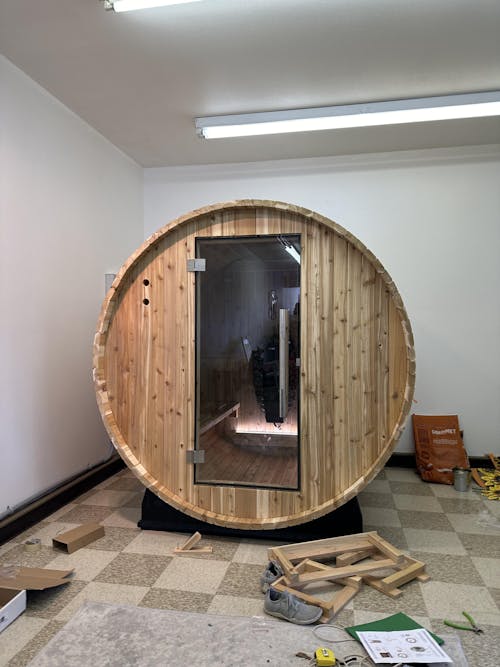
We ordered the 4 person barrel sauna and love it! We wanted a little extra space for the 2 of us/guests and it’s great. We could definitely fit 4 people in it if we needed. We use it every single day. It took about 10 weeks to get here because they build it specifically for the order. Putting the barrel together was fairly easy with 2 people. The electrical and the heater definitely required an electrician to install as we could have not done it alone.
We ordered the biggest heater (harvia spirit 8kw) and it heats up the sauna in about 15 mins inside our 40-50° garage. Overall this style of sauna is hotter and you sweat a lot faster than in an infrared sauna. I truly 10/10 recommend!
Pic is of us in the middle of building it.
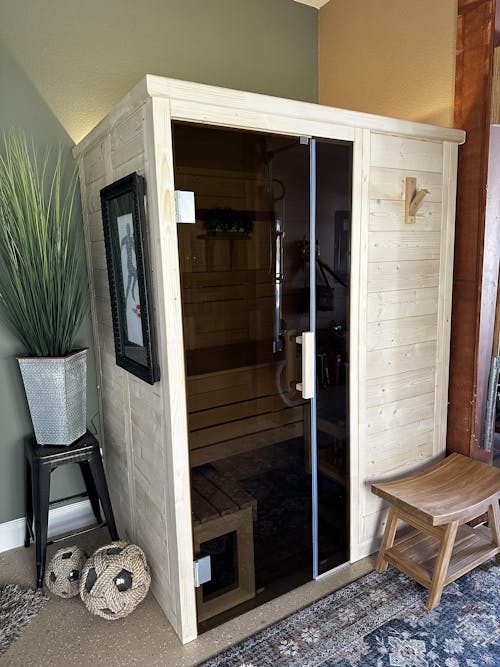
Took me about 6 hours over 2 evenings to assemble almost all by myself. Had a pro run a new circuit from my panel. Very well made and assembly was straightforward. Heater is well sized and reaches operating temperature in under 30 minutes.
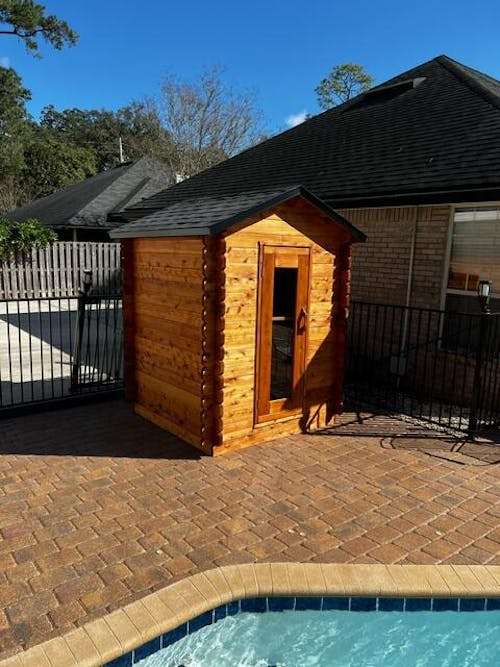
Great sauna very easy to assemble

The salt panel was a great addition to our Madison Sauna. It has excellent grain which is accented by the amazing color lights that glow through the panel. Also when you hit the rocks with a splash of water you can feel the heat bounce off the panel. Great addition if you are considering this option.
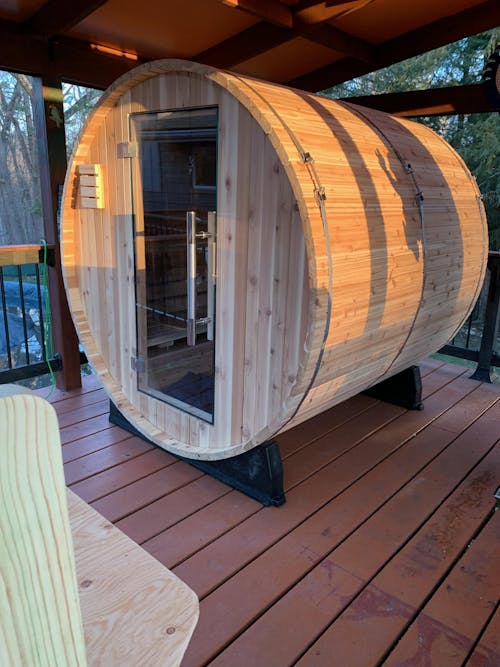
We can say enough about Sauna World there customer support is great! Our Pinnacle Sauna from Almost Heaven is epic.
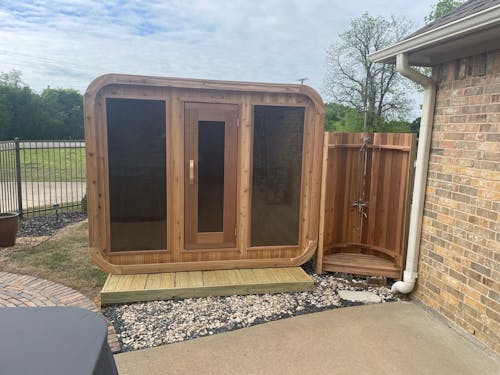
The finish and quality is outstanding and it was quick and easy to assemble.
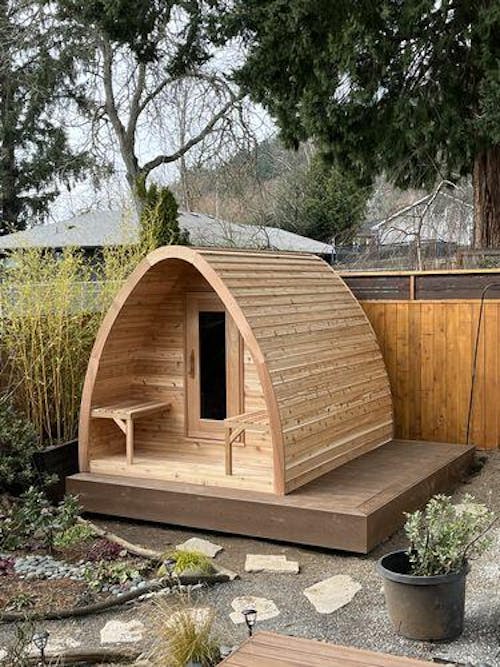
We are thrilled with our mini pod!! It came well shipped and our friend assembled it in 11 hours! Wow! We cannot wait to get healthy and sauna it up!
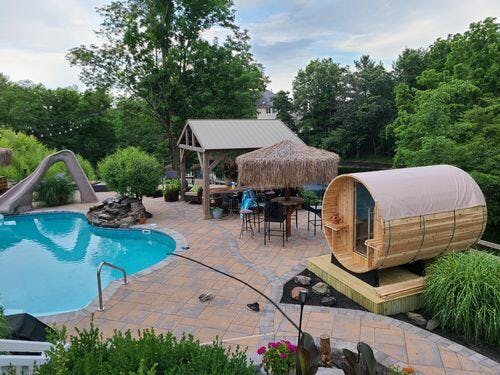
Beautiful sauna!!! Much easier than I expected to assemble, took a total of 4 hours. Can't wait to get warm by the pool on those cool evenings. Customer service was excellent..

Purchased a 2 person Almost Heaven barrel sauna and were delighted with the product. The order process was quick and easy, the sauna arrived on-time, installation was simple, following the provided instructions, and the sauna is extremely high quality. We’ve used it daily for over 2 weeks and quite frankly I don’t know how we lived without it. If I had it to do over again I wouldn’t change a thing... except maybe purchasing a 4 person model to easier share with friends!
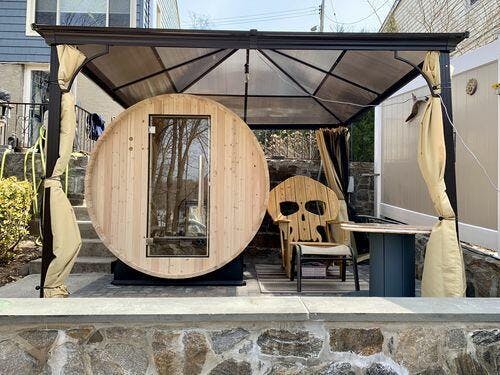
Great Customer Service and a breeze to put together.Excellent shipping and the Sauna is top notch, couldn’t be happier






























